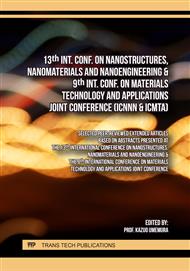[1]
C. Zamora-Ledezma, D. Negrete-Bolagay, et.al. Heavy Metal Water Pollution: A Fresh Look about Hazards, Novel and Conventional Remediation Methods. Environ. Technol. Innov.(2021).
DOI: 10.1016/j.eti.2021.101504
Google Scholar
[2]
S. Mitra, A.J. Chakraborty, et al. Impact of Heavy Metals on the Environment and Human Health: Novel Therapeutic Insights to Counter the Toxicity. J. King Saud Univ. - Sci. (2022).
Google Scholar
[3]
C. Mao, Y. Song, et.al. Human Health Risks of Heavy Metals in Paddy Rice Based on Transfer Characteristics of Heavy Metals from Soil to Rice. CATENA (2019).
DOI: 10.1016/j.catena.2018.12.029
Google Scholar
[4]
Z. Fu, S. Xi. The Effects of Heavy Metals on Human Metabolism. Toxicol. Mech. Methods (2020).
Google Scholar
[5]
A. Alengebawy, S.T. Abdelkhalek, et.al. Heavy Metals and Pesticides Toxicity in Agricultural Soil and Plants: Ecological Risks and Human Health Implications. Toxics (2021).
DOI: 10.3390/toxics9030042
Google Scholar
[6]
M. Liu. Optical Properties of Carbon Dots: A Review. Nanoarchitectonics (2020).
Google Scholar
[7]
X. Wang, P. Yang, et.al. Green Preparation of Fluorescent Carbon Quantum Dots from Cyanobacteria for Biological Imaging. Polymers (2019).
Google Scholar
[8]
J. Liu, R. Li, et.al. Carbon Dots: A New Type of Carbon-Based Nanomaterial with Wide Applications. ACS Cent. Sci. (2020).
DOI: 10.1021/acscentsci.0c01306
Google Scholar
[9]
M. Jorns, D. Pappas. A Review of Fluorescent Carbon Dots, Their Synthesis, Physical and Chemical Characteristics, and Applications. Nanomaterials (2021).
DOI: 10.3390/nano11061448
Google Scholar
[10]
H. Su, Z. Bi, Y. Ni, L. Yan. One-Pot Degradation of Cellulose into Carbon Dots and Organic Acids in Its Homogeneous Aqueous Solution. Green Energy Environ. (2019).
DOI: 10.1016/j.gee.2019.01.009
Google Scholar
[11]
J. Woo, Y. Song, J. Ahn, H. Kim. Green One-Pot Preparation of Carbon Dots (CD)-Embedded Cellulose Transparent Film for Fe3+ Indicator Using Ionic Liquid. Cellulose (2020).
DOI: 10.1007/s10570-020-03099-5
Google Scholar
[12]
N.A. Abdullah, M.S.A. Rani, et.al. Nanocellulose from Agricultural Waste as an Emerging Material for Nanotechnology Applications – an Overview. Polimery (2021).
Google Scholar
[13]
A. Mtibe, M. John, et.al. Sequential Extraction of Carbohydrates and Lignin from Agricultural Waste and Their Structural Characterization. Biomater. Polym. Horiz. (2022).
Google Scholar
[14]
G.S. Das, J.P. Shim, et.al. Biomass-Derived Carbon Quantum Dots for Visible-Light-Induced Photocatalysis and Label-Free Detection of Fe(III) and Ascorbic Acid. Sci. Rep. (2019).
DOI: 10.1038/s41598-019-49266-y
Google Scholar
[15]
S. Jayaweera, K. Yin, X. Hu, W.J. Ng. Facile Preparation of Fluorescent Carbon Dots for Label-Free Detection of Fe3+. (2019).
DOI: 10.1016/j.jphotochem.2018.10.052
Google Scholar
[16]
L. Zhang, Y. Wang, W. Liu, Y. Ni, Q. Hou. Corncob Residues as Carbon Quantum Dots Sources and Their Application in Detection of Metal Ions. Ind. Crops Prod. (2019).
DOI: 10.1016/j.indcrop.2019.03.019
Google Scholar
[17]
B. Wang, S. Lu. The Light of Carbon Dots: From Mechanism to Applications. Matter (2022).
Google Scholar
[18]
C. Wang, T. Hu, et.al. Concentration-Dependent Color Tunability of Nitrogen-Doped Carbon Dots and Their Application for Iron(III) Detection and Multicolor Bioimaging. J. Colloid Interface Sci. (2018).
DOI: 10.1016/j.jcis.2018.03.021
Google Scholar
[19]
J. Shi, G. Ni, et.al. Green Synthesis of Fluorescent Carbon Dots for Sensitive Detection of Fe2+ and Hydrogen Peroxide. J. Nanoparticle Res. (2017).
DOI: 10.1007/s11051-017-3888-5
Google Scholar
[20]
D. Rodríguez-Padrón, M. Algarra, et.al. Catalyzed Microwave-Assisted Preparation of Carbon Quantum Dots from Lignocellulosic Residues. ACS Sustain. Chem. Eng. (2018).
DOI: 10.1021/acssuschemeng.7b03848
Google Scholar
[21]
W.U. Khan, D. Wang, Y. Wang. Highly Green Emissive Nitrogen-Doped Carbon Dots with Excellent Thermal Stability for Bioimaging and Solid-State LED. Inorg. Chem. (2018).
DOI: 10.1021/acs.inorgchem.8b02524
Google Scholar



